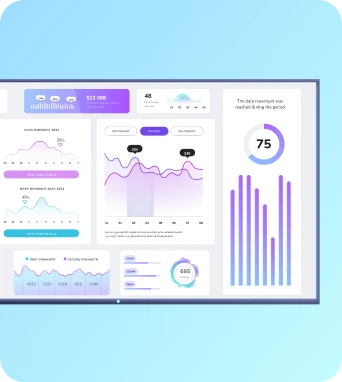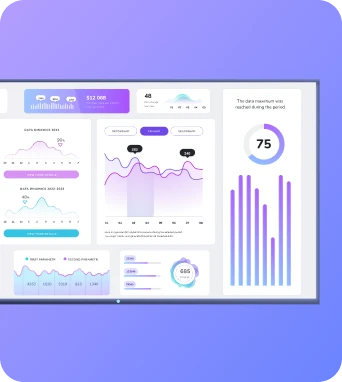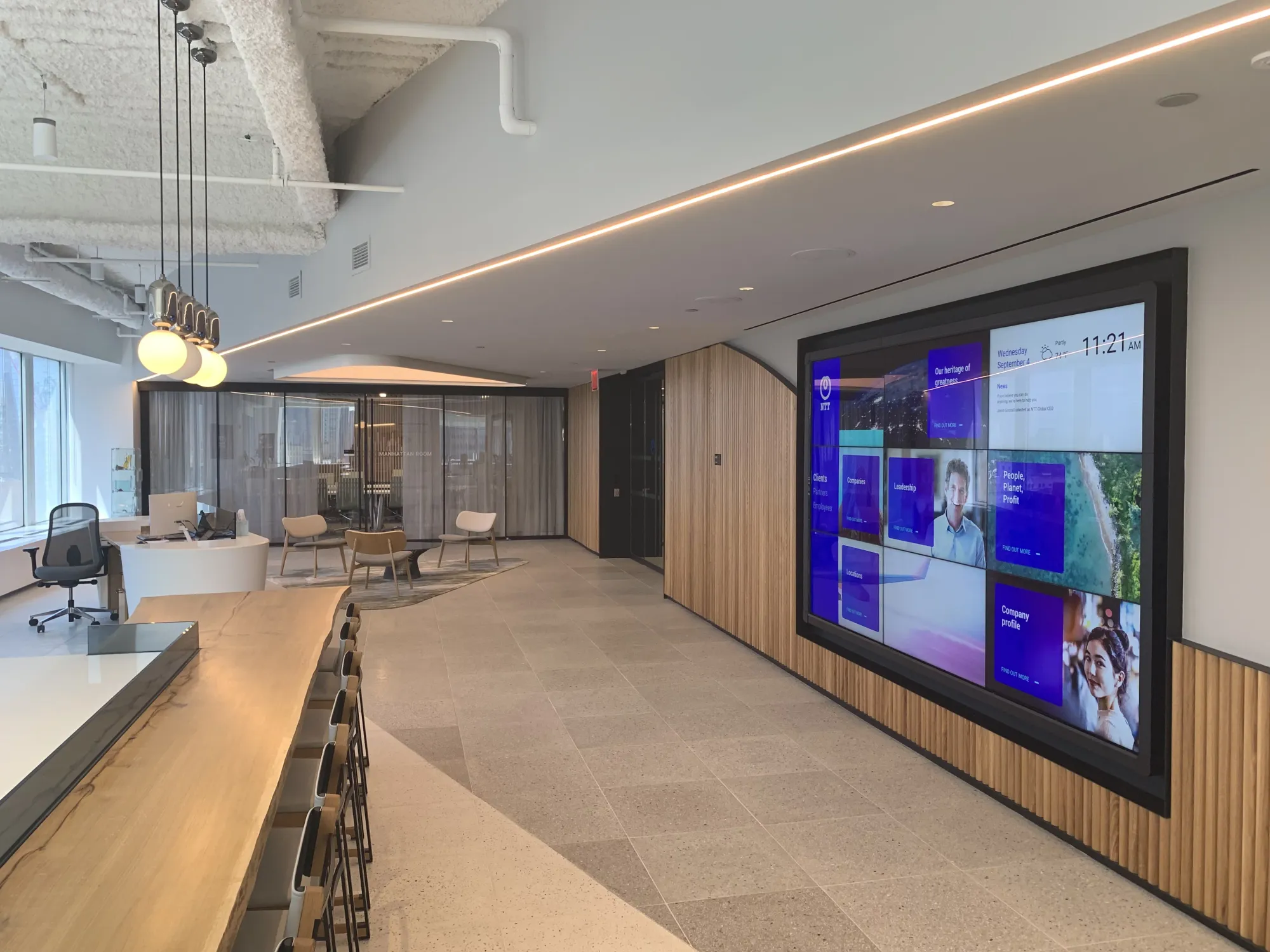So digital signage displays are a lot of fun — but they’re a lot less fun if they put your business at risk.
Spammers, scammers, and mischief-makers know exactly how to siphon information from your signage solutions. Hardware can get compromised, login credentials can get exposed, and you might suddenly find bad actors prying their way into your private affairs.
The number of business-related cyber threats climbed to 2,365 in 2023, so it’s clear proper cybersecurity protocols matter more than ever. That's why now is a great time to tap into digital signage security: so you can protect your business, customers, and intellectual property from potentially expensive mistakes.
So you’re telling me my digital signage isn't safe?
We won’t sugarcoat it: bad actors can manipulate almost anything these days. And yes, this includes your digital signage.
More and more cases get reported each year. From the Bristol Airport to Liverpool's billboards, there are dozens of bone-chilling examples of breached systems, networks, and display screens.
So what makes digital signage vulnerable to hacking attempts?
Let's take a look at the most common security vulnerabilities:
- Sensitive data. If you're setting up a TV dashboard, for example, you need a stalwart provider to protect your credentials.
- Network settings. Any compromised device connecting to your network could provide direct access to your systems, leading to equally compromised websites, apps, or platforms.
- Social engineering attacks. Bad actors may try to trick users into giving them credentials by installing malicious software or downloadable files.
Digital signage security involves more than just virtual cyberattacks. You also need to think about in-person saboteurs — i.e., that customer with an amazingly ‘funny’ idea to update your signage with something NSFW.
The good news is that you’re not doomed to get hacked, and there aren’t rampant packs of teenagers looking to ruin your signage with memes.
If you can purchase the right hardware and put routine audits in place, you can stave away unpleasant incidents and keep your digital signage secure.
How to tap into digital signage security
The last thing you want is for your digital signage system to fall into the wrong hands.
The good news is, with proper security measures, your likelihood of attack will drop considerably.
Here are seven ways to get started with digital signage security, starting with the most practical suggestion:
1. Perform regular security audits
There's no way to forecast everything that could happen to your digital signage — unless you take the time to put yourself in a hacker’s shoes. And by ‘shoes,' we mean performing an audit of current security measures (and surveying potential risks) in your digital and physical spaces.
First consider your hardware security risks. Where are you mounting your screens and devices?
Then, consider your virtual data risks. Are you currently using a secure digital signage solution?
Try to survey your digital signage security standing at least once per month. Remember: circumstances can change at the drop of a hat, so it pays to be prepared even if you don't think you're currently at risk.
2. Enforce physical security measures
Apart from digital cyber threats, you should secure your digital signage hardware against unauthorized access. This means amping up hardware security for devices, players, and kiosks, as well as other screens you manage across businesses.
Some suggestions:
- Store your digital signage hardware in a well-protected area. For example, you can hide your player behind a reception desk or near your security cameras.
- If you don't have a way of keeping your players at a distance, do your best to warn customers by hanging 'only authorized personnel' signs.
- Speaking of security cameras, try pairing TV screens with mounted cameras so you can keep an eye out for vandals. This might be easier to manage in a corporate network, but there are plenty of battery security cameras you can use in tight or awkward spaces.
- Keep critical devices in their own unique lockboxes. Try not to make these stand out i and purchase separate locks for all the boxes.
Worried about losing vital equipment? You might want to consider TV cages or recessed enclosures.
3. Think about hardware security
It's not just about how you physically protect your hardware. It's also about the hardware itself.
For example, the operating systems on some players and screens are more resistant to cyber threats than others. Depending on your risk level or specific industry, they may be worth the extra investment.
ChromeOS devices are a great example of this. The built-in security is second to none: and so far, the OS has never recorded a major incident.
Another great option is the Raspberry Pi 5. That said, be sure to perform firmware updates as often as you can to lower your risks of successful hacking attempts.
Other digital signage screens come with special features such as password-protected BIOS and PC ports. The bottom line is to know thy vendor (and get your IT team involved each time you vet a new product).
4. Choose a digital signage system with proper security measures
This includes digital signage software like Fugo — the easiest way to build digital signage for small businesses.
Fugo’s platform offers robust security features that both small businesses and enterprises can feel good about using.
We offer:
- User access control. No one gets into your signage unless you've told them so.
- Remote monitoring. You can see what's being displayed on your screens from anywhere with an internet connection.
- GDPR and CCPA compliant. We adhere to all standards in the General Data Protection Regulation and the Data Protection Act 2018 (DPA).
- SOC2 compliant. This involves an extensive security audit, which is similar to what the certification process involves for ISO 27001.
- Data encryption. We store your encrypted credentials in AWS Secrets Manager, which can only be accessed through our private servers.
- Microsoft security measures. Keep a close eye on your network traffic, operating systems, and sensitive information.
Learn more about how Fugo is helping to safeguard digital signage networks.
5. Restrict access to only the essentials
Maybe not everyone should get invited to your digital signage club. This isn’t necessarily about ‘being mean’ or gatekeeping’ — it’s more about limiting access to sensitive data.
For example, your finance team should only have access to payments, billing, and finance screens. Your graphic designer should only have access to your design studio, and your sales team should have view-only access to content.
You may also want to implement two-factor authentication, otherwise known as 2FA. Everyone on your team can other connected devices to prove that they (not someone else) is actually logging into their account.
Again, this security measure isn't about not trusting your team: it's about reducing your exposure to slip-ups, phishing attempts, and data breaches.
Platforms like Fugo make this easy with built-in user access control features, which means you can set up roles and permissions and reduce your risks for data breaches. You can even tap into Single Sign On (SSO) tools and Whitelist IP addresses so you can sleep easier at night.
6. Keep an eye on the technical bits
Be warned: we're about to get technical.
But if you want to ensure maximum security for your signage, you need to make sure you're not inadvertently making yourself an easy target.
This typically starts with network segmentation, which is the process of splitting a computer network into multiple parts. If bad actors gain access to one part of your system, they won’t have their hands on your entire network.
Do your best to create a secure environment with separate firewalls, VLANs, and security checkpoints. And be sure not to connect to any open guest networks — this is a surefire way to invite a security problem.
Another consideration: stronger encryption protocols. These help secure data transmission and prevent security breaches, which ultimately protects sensitive information and data feeds.
It’s a good idea to tap into SSL or TLS so you can defend traffic between your digital signage player and your content management system. That way, bad actors can't intercept data going to digital signs, and you can rest easy knowing your data is protected.
7. Design security breach recovery strategies
When, not if, you experience an attack, you'll want to have an emergency plan describing next steps. This should obviously be specific to your business and not necessarily cut and paste. However, you may want to include next steps for:
- Data breaches. It's a good idea to back up your data (i.e., content screens and designs) whenever possible.
- Damage assessments. How much was taken, destroyed, or vandalized?
- Finding the source. You may want to contract with a company for this.
- Re-securing digital signage systems. How much support can you expect from your digital signage provider?
- Training employees. Can you use this as a teachable moment?
Make the safer choice with Fugo.ai
Your digital signage isn't something to gamble with. But by checking the right boxes, you can substantially lower your security risks.
But the easiest way to steer clear of security threats is to partner with a digital signage system that prioritizes your safety. At Fugo, we care as much about security threats as you do — which is why we’re trusted by hundreds of growing businesses to securely manage their digital signage software.
No need to take our word for it, though.






